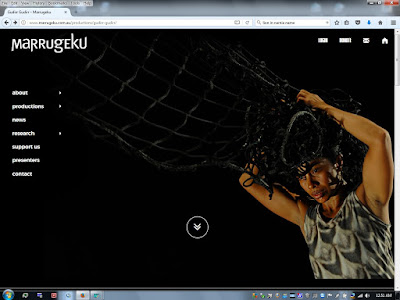Gudirr Gudirr Dance-Drama. Marrugeku (Broome) at Canberra Theatre Centre, The Playhouse, September 30, 2017.
Concept, performer & co-choreographer: Dalisa Pigram
Director & co-choreographer: Koen Augustijnen
Set designer & video artist: Vernon Ah Kee; Costume Designer: Stephen Curtis
Composer & sound designer: Sam Serruys; Singer & songwriter: Stephen Pigram
Lighting designer: Matthew Marshall; Concept & cultural adviser: Patrick Dodson
Dramaturg & creative producer: Rachael Swain; Video production: Sam James
Rigging designer: Joey Ruigrok Van Der Werven
Reviewed by Frank McKone
Gudirr Gudirr is a remarkable powerful work, dancing the story of the Pigram family of Broome, on the west coast of the Kimberley region in the far north of Western Australia. Dalisa Pigram’s performance is quite extraordinary, developed from improvisations working closely with the Belgian choreographer and dancer Koen Augustijnen who typically mixes dance styles, theatre, acrobatics, music and visual arts.
The resulting work is entirely informed by the history and culture of the mixed heritage represented in the Pigram family: Yawuru Aboriginal, Malay, Filipino, Irish, English and Bardi people from Cape Leveque north of Broome. As the ABC reported in 2006, ‘the Pigram family is a big one; there’s almost 100 of them and by marriage they’re related to nearly everyone else in Broome’.
[ www.abc.net.au/local/stories/2006/12/30/1819251.htm ]
So, though the story is particular to her family, it represents the the experiences of people from all over Australia, beginning especially from the time of West Australian Chief so-called ‘Protector’ of Aborigines, A O Neville (b 1875, d 1954) [ see www.adb.anu.edu/biography/neville-auber-octavius-7821 ]
But Dalisa’s story is not all about such mistreatment. There is joy in fishing with her father, recognition of normal living in hearing the call of the guwayi bird when the tide is turning, and moving to the music of her famous father’s Pigram Brothers Band. But there is also frustration that after all this time there is conflict, young people taking their own lives, and social inequality. A fishing net hangs down as if from the sky for Dalisa to climb, hang from and spin, and sometimes to hide in or even seem to be imprisoned in, while words or photos of family, or videos appear and even fill a screen which seems to be made of corrugated iron, an Australian iconic building material.
The moods come and go, often with a sense of humour and, even though ending with a painful sense of questioning the way things are now and will be in the future, the work remains a sincere, truthful, objective presentation of life. We are left to understand, to empathise, and to appreciate the strength and resilience of these people who can create such music and dance.
This is an important artistic work which is not to be missed.
 |
| Dalisa Pigram in Gudirr Gudirr |
